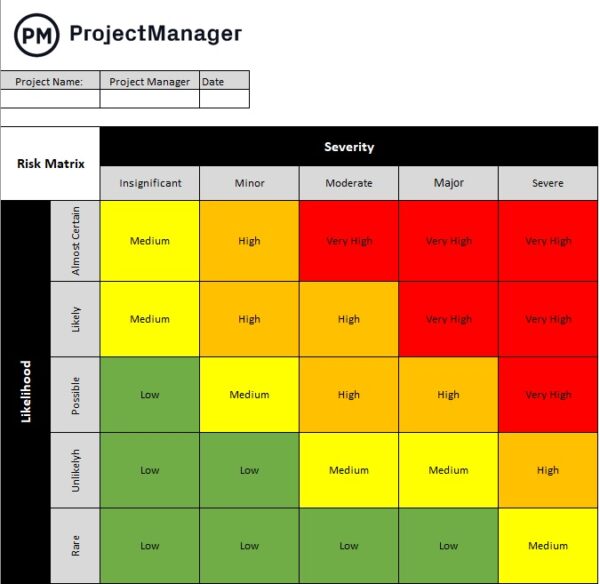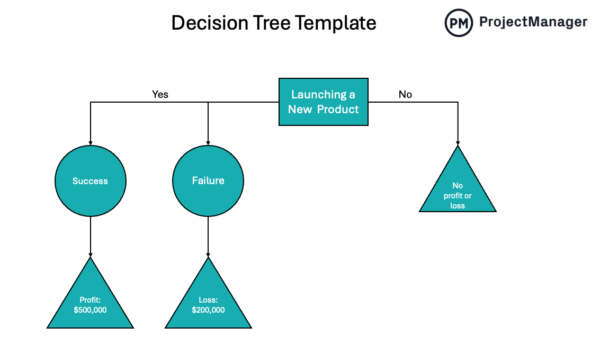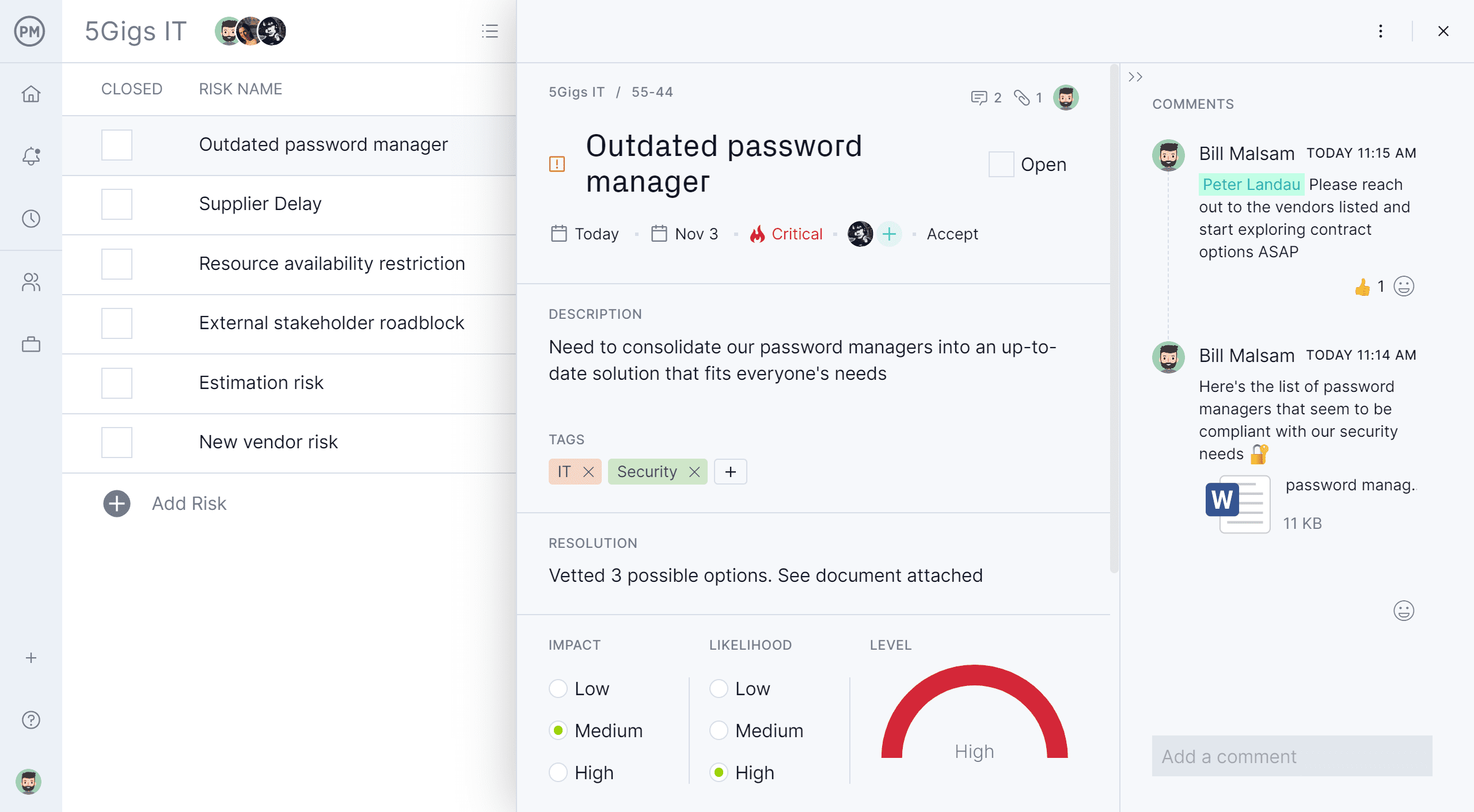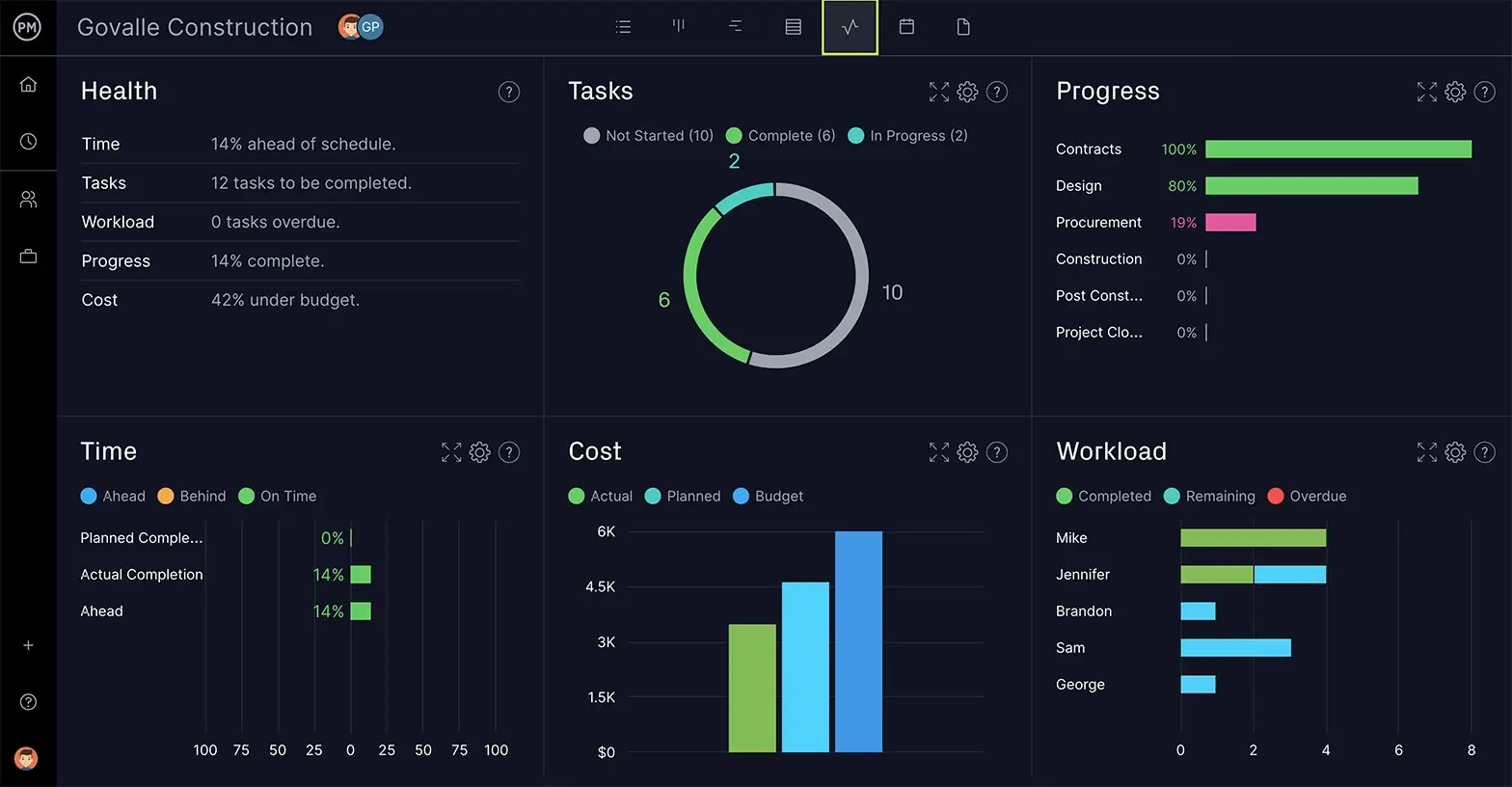There are many project risks that can affect your project and, as a project manager, you’re responsible for the risk analysis process. Risk analysis, or risk assessment is essential because it allows project managers to classify project risks and determine which of them should be tracked closely.
What Is Project Risk Analysis?
Risk analysis consists of using tools and techniques to determine the likelihood and impact of project risks that have been previously identified. Therefore, risk analysis helps project managers decipher the uncertainty of potential risks and how they would impact the project in terms of schedule, quality and costs if, in fact, they were to show up. Risk analysis isn’t exclusive to project management and it’s used in other disciplines such as business administration, construction or manufacturing.
Manage Risk Online With ProjectManager
No matter what industry you’re in, you’ll always have projects. Try project management software for risk analysis. ProjectManager, for instance, has risk management tools that let you track risks in real time.
- Keep track of individual risk events alongside in-depth project plans
- Mark risk impact, likelihood and overall risk level with a matrix
- Assign risk to a team member and use real-time dashboards to monitor. Try it free.

Who Is Responsible for Risk Analysis?
Several roles, including the project manager and the project team, are typically responsible for risk analysis. The project manager takes on the main responsibility as they oversee the process, helping to document risks in a risk register. They are typically in charge of facilitating risk identification and analysis sessions with the team and stakeholders. They will prioritize the risks based on their likelihood and impact, usually using tools such as a risk matrix.
Project team members are also responsible for identifying potential risks related to their areas of expertise. They offer insights into the likelihood of and potential impact of identified risks. Project sponsors may also be involved, defining the overall risk tolerance for the project and approving major risk responses.
How to Analyze Project Risks
At a basic level, there are three things you should consider when assessing project risks: risk probability, risk impact and risk exposure. These three things can be estimated through qualitative and quantitative risk analysis.
Risk Probability
All risks have a certain probability of occurrence, which means they might or might not happen. Estimating risk probability isn’t an exact science, but there are several techniques you can use, such as examining data from past projects. By analyzing similar projects from the past, you can better determine whether there’s a high or low chance of project risk.
Risk Impact
Consider the type of risk and its potential impact on the project. Some risks will bring financial stress, while others might involve resource management issues or delays to the project schedule. To make things simple, you can simply assign levels of impact for your project risks, such as low, medium or high depending on how critical they are.
Risk Exposure
Risk exposure combines risk probability and risk impact in one formula that’s used by businesses to determine whether they’re ready to assume a potential risk or not. This technique can only be used when you can measure the potential losses associated with risk. The risk exposure formula is:
Risk Exposure = Risk impact * Risk probability
So, if a given risk had an impact of $1 million and the probability of that risk was 50%, your risk exposure would equal $500,000.
Why Does Project Risk Analysis Matter?
Project risk analysis is largely important as it can help improve the chances of project success. It encourages a forward-thinking approach, prompting the project team to identify potential problems and challenges before they occur. Risk analysis also allows for more informed decisions, helping project managers weigh potential rewards against the possible downsides.
Once risks are identified, they can be prioritized based on their likelihood and impact. As a result, the team can focus its attention and resources on the most critical threats and opportunities. From there, they can develop mitigation strategies to minimize the potential damage to the project’s objectives. This can be facilitated through both qualitative and quantitative risk analysis.
Types of Risk Analysis: Qualitative and Quantitative
There are two main types of risk analysis: qualitative and quantitative risk analysis. Let’s learn about these two approaches.
Qualitative Risk Analysis
The qualitative risk analysis is a risk assessment done by experts on the project teams who use data from past projects and their expertise to estimate the impact and probability value for each risk on a scale or a risk matrix.
The scale used is commonly ranked from zero to one. That is, if the likelihood of the risk happening in your project is .5, then there is a 50 percent chance it’ll occur. There is also an impact scale, which is measured from one to fine, with five being the most impact on the project. The risk will then be categorized as either source- or effect-based.
Once risks are identified and analyzed, a project team member is designated as a risk owner for each risk. They’re responsible for planning a risk response and implementing it.
Qualitative risk analysis is the base for quantitative risk analysis and reduces project uncertainty while focusing on high-impact risks. This allows you to assign a risk owner and plan out an appropriate risk response. Get started with qualitative risk analysis with our free risk assessment template.
Quantitative Risk Analysis
By contrast, quantitative risk analysis is a statistical analysis of the effect of those identified risks on the overall project. This helps project managers and team leaders to make decisions with reduced uncertainty and supports the process of controlling risks.
Quantitative risk analysis counts the possible outcomes for the project and figures out the probability of still meeting project objectives. This helps with decision-making, especially when there is uncertainty during the project planning phase. It helps project managers create cost, schedule or scope targets that are realistic.
The Monte Carlo simulation is an example of a quantitative risk analysis tool. It’s a probability technique that uses a computerized method to estimate the likelihood of a risk. It’s used as input for project management decision-making.
11 Project Risk Analysis Methods & Techniques
There are several risk analysis methods and tools that help managers through the analysis and decision-making process. Some of these involve the use of risk analysis tools such as project management charts and documents. Let’s dive into these risk analysis methods and how they can help you.
1. Team Brainstorming Sessions
Estimating risk probability and impact is a huge part of risk analysis. As stated, this can be done subjectively, which might lead to error, especially if you do it by yourself as the project manager. To avoid this, you can involve all the team members you consider relevant to get their input on risk likelihood and potential negative consequences.
2. Delphi Technique
The Delphi technique involves a panel of experts on topics that are critical to your project risk. It could be financial experts, lawyers, project management consultants or any other type of professional. This risk analysis method consists of promoting a debate among these experts who ultimately need to reach a consensus on a particular topic, such as estimating the business impact of a risk.
3. Risk Interviews and Surveys
These can help gather information, perspectives and insights from stakeholders and team members about potential risks. They’re structured or semi-structured conversations using open-ended questions to encourage interviewees to share their concerns, past experience and potential future issues. This risk analysis tool allows for a deeper understanding of individual perspectives and reasoning behind their risk assessments. The questions can also be tailored to the specific role and expertise of the interviewee.

4. SWOT Analysis
SWOT analysis allows managers to understand the current situation of their business or project by looking at its strengths, weaknesses, opportunities and threats. As a risk analysis tool, it lets you note which of your weaknesses might be exploited by others and which external threats might affect your projects, such as economic conditions or the threat of new competitors.

5. Risk Analysis Matrix
The risk analysis matrix assesses the likelihood and the severity of risks, classifying them by order of importance. It’s main purpose is to help managers prioritize risks and create a risk management plan that has the right resources and strategies to properly mitigate risks. Risk likelihood is measured on a relative scale, not a statistical one, which makes it a qualitative risk analysis tool. This tool is also called the probability/consequence matrix by some project managers.

6. Risk Register
A risk register is a crucial project management tool to document project risks. It’s a document that lists all the potential risks that could occur during the project execution phase, as well as critical information about them. It’s meant to be used as input for the risk management plan, which describes who’s responsible for those risks, the risk mitigation strategies and the resources needed. Creating a risk register usually involves several reliable information sources such as the project team, subject matter experts and historical data.

7. Decision Tree Analysis
A decision tree analysis consists of mapping out the potential outcomes that might occur after a decision is made. This is a great method to analyze risks in new projects. Create decision trees as you go through your project planning process so you can identify potential risks and their probability and impact along the way.

8. Root Cause Analysis
A root cause analysis (RCA) dives deeper into risks to understand what underlying causes might be contributing to them occurring in the first place. For example, while traditional risk analysis might identify “supplier delays” as a risk, RCA would go further, asking “why might suppliers be delayed?” This allows teams to develop more targeted and effective risk response strategies.
9. Bow Tie Analysis
This qualitative risk analysis method is used to identify causes and consequences for all potential project risks. The project management team must first identify risks that might affect the project and then think about causes, consequences and more importantly, a risk mitigation strategy for them. It’s a versatile method that can be used in any industry.
10. SWIFT Analysis
SWIFT stands for Structured What If Technique. It’s a risk analysis method that focuses on identifying potential risks associated with changes made to a project plan. As its name suggests, team members have to come up with any “what if” questions they can to find out all the potential risks that could arise.
11. Contingency Planning
This is another risk analysis tool that involves developing pre-defined actions or strategies to implement if an identified risk occurs. It’s sometimes seen as the “plan B” for when things don’t go as planned. Once a risk is identified, it is analyzed to understand its likelihood and potential impact. Contingency planning directly relates to developing a risk response plan, as it outlines the steps to take if the risk occurs. If a risk materializes, having a pre-prepared plan helps develop a swift, organized response.
Benefits of Risk Analysis
There are many benefits to using risk analysis in your projects. Here are some of the most common ones.
- Avoid potential litigation
- Address regulatory issues
- Comply with new legislation
- Reduce exposure
- Minimize impact
Risk analysis is an important input for decision-making during all the stages of the project life cycle. Project managers who have some experience with risk management are a great resource. We culled some advice from them, such as:
- There’s no lack of information on risk
- Much of that information is complex
- Most industries have best practices
- Many companies have risk management framework
Project Risk Analysis Templates
There are several quantitative and qualitative risk analysis methods. There are several tools that can be used for different purposes. To help, we’ve prepared some free risk analysis templates to help you through the risk analysis process.
Risk Register Template
This risk register template has everything you need to keep track of the potential risks that might affect your project as well as their probability, impact, status and more.
Risk Analysis Matrix Template
This risk matrix template lets you visualize your project risks in one color-coded graph to classify them by likelihood and severity. This allows you to better understand the most critical risks for your project.
Risk Analysis In Project Management
Risk analysis is a fundamental step in the project risk management process, which consists of four main stages.
- Risk identification: First, identify your potential project risks and list them using a risk register.
- Risk analysis: Now, estimate the impact, likelihood and exposure for each risk and assign a priority level based on this information. The higher the priority level, the more resources are allocated to mitigate the risk.
- Create a risk management plan: Create risk mitigation strategies, or contingency plans to alleviate the impact of each project risk you’ve previously analyzed. These details are usually included in a risk management plan.
- Track risks until project completion: Implementing your risk management plan is as important as creating one. Set up project controls to keep track of risk at all times.
Risk Analysis Video
If we’ve caught your attention when it comes to discussing risk analysis on a project, don’t worry. Watch project management guru Jennifer Bridges, PMP, as she helps visualize how to analyze risks on your project.
Here’s a shot of the whiteboard for your reference!
Thanks for watching!
How ProjectManager Helps Your Risk Analysis
ProjectManager is online work and project management software that allows you to manage risks alongside your project. Activate the Risk View to create a running list of all of your project risks. Then add descriptions, mark likelihood, impact and level with an embedded risk matrix. Work towards resolutions with your team and add comments along the way.

Project Tracking You Can Trust
It’s hard to recognize risk without a proper project tracking system in place. Across all of ProjectManager’s views, you can monitor progress and communicate with your team as you work together. But, to take it even further, leverage our built-in dashboards and project reports to stay on top of all aspects of your projects, so you’re ready to identify risks as soon as they appear.

Analyzing and resolving risk is a team effort and our software is collaborative to the core. Teams can comment, share files and get updates from email notifications and in-app alerts. There’s one source of truth and you’re always getting real-time data so everyone is on the same page. Get started with ProjectManager today for free.

